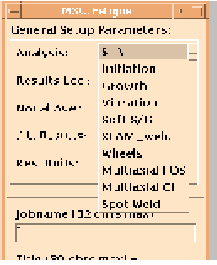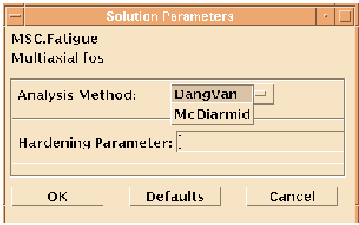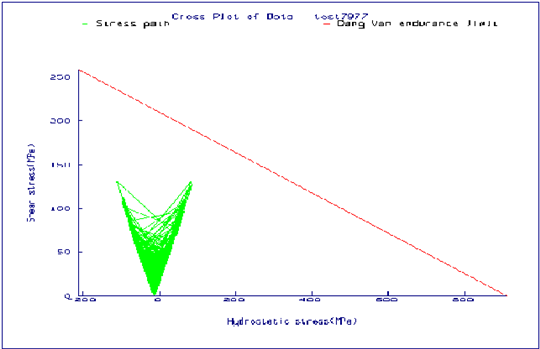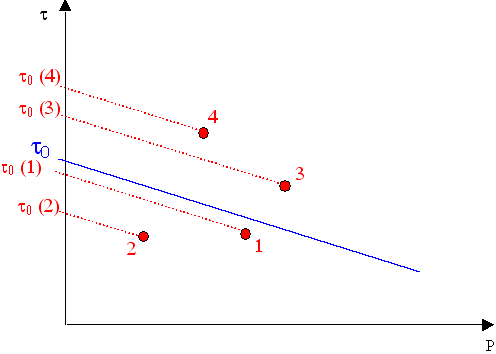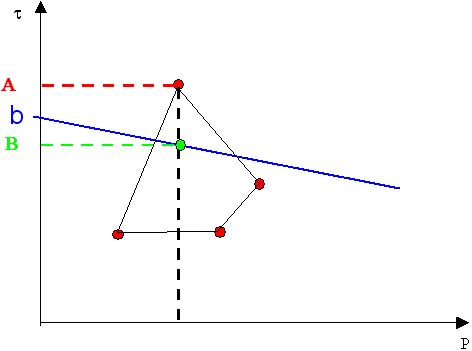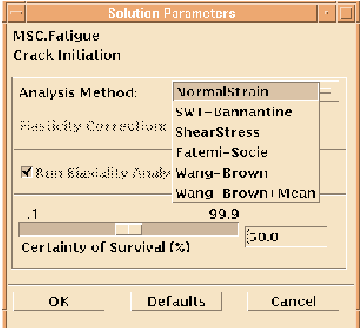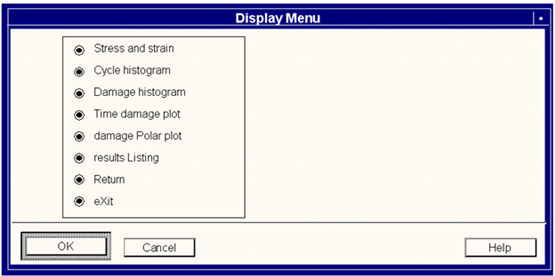XXXXXXXXXXXXXXXXXXXXXXXXXXXXXXXXXXXXXXXXXXXXXXXXXXXXXXXXXXXXXXXXXXXXXXXXXXXXXXXXXXXXXXXXXXXXXXXXXXXXXXXXXXXXXXXXXXXXXXXXXXXXXXXXXXXXXXXXXXXXXXXXXXXXXXXX''"> Global Multiaxial Fatigue Life Analyzer
This chapter on multiaxial life prediction consists mainly of a description of the multiaxial fatigue analysis module FEMLF. This module can be accessed from Analysis on the Main Fatigue form (Analysis > Multiaxial FOS or Multiaxial CI).
This analysis module allows fatigue life predictions and safety factor calculations to be made, even when the loadings are complex and multiaxial, including both proportional and non-proportional loadings. It should be kept in mind that if you are dealing with proportional or near proportional loadings, you may find the standard MSC Fatigue options give sufficiently good results.
The programs normally used during the execution of a multiaxial fatigue analysis are as follows:
1. Data Preparation
| Materials Database Manager and BS5400 Weld Classification Advisor |
| Time History Database Manager and ASCII Time History File Convertor |
| A Peak-Valley Extraction Program for Reducing Lengthy Time Histories |
| A Multi-file Display Program |
2. Fatigue and Factor of Safety Analysis
PAT3FAT | Model database (MSC Patran) to Fatigue Input Translator |
FATTRANS | The new model database (MSC Patran) to Fatigue Input Translator |
FEMLF | Multiaxial Fatigue and Safety Factor Analyzer |
3. General Utilities
FEFAT | FES File ASCII/Binary Convertor |
| Terminal Driver |
| Binary to Binary File Convertor |
FASTAN | Utility to run a peak-valley extraction and subsequent analysis to speed up execution time |
4. Results Postprocessing
MPOD | Polar damage display module |
MP3D | 3-D Histogram display module |
MTPD | X-Y plotting |
PFPOST | Global Results Listing |
MMFD | Multi-File Display |
Analysis Route
The actual programs necessary to complete a global multi-node or element crack initiation analysis are:
PAT3FAT | Translator (creates the fatigue input file filename.fes) |
FATTRANS | New Translator (creates the fatigue input file filename.fes) |
FEMLF | Multiaxial fatigue and factor of safety analyzer |
Most of the options in this module require surface resolved stresses, i.e. results either from thin shells or using the surface normal extract option for solid models. The exception is the Dang Van method which accepts 2-D or 3-D stresses.
The results may be reviewed using PFPOST, by reading them back into the pre-/postprocessor for postprocessing, or by using the graphical options in FEMLF.
In summary, to run a multiaxial fatigue or safety factor analysis:
1. Select the analysis option (Multiaxial FOS or Multiaxial CI). Make sure that, if you are using a solid model, you first run the surface normal extract option from the job control menu (this step is not necessary if either you already have 2-D stresses or you are running a Dang Van analysis).
2. Select Solution parameters and fill in the required fields for the analysis Method selected. The input forms are different depending on the analysis option selected above.
3. Select Materials Info and fill in the required fields for the material form. Limited true multiaxial (FOS and CI) materials data is available for Dang Van, Fatemie-Socie and Wang Brown respectively. Users may add multiaxial data with reference to the rules in
Problem 4: Ten Simple Notched Geometries (Ch. 14).
4. Select Load information and fill out the loading form.
5. Select Job control and submit the analysis.
6. Post-process the results using FEMLF, PFPOST and by reading the results back into the pre-/postprocessor (MSC Fatigue Pre & Post or MSC Patran).
The analysis should produce a jobname.fef or jobname.fos result files.
Multiaxial Fatigue Analysis Options
The Multiaxial Analysis options are selected from the main MSC Fatigue form as shown in
Figure 6‑1.
Figure 6‑1 MSC Fatigue Main form
Safety Factor Analysis
On the Solution Parameters form select the Analysis method. If Dang Van is selected the Users is required to input a hardening parameter.
Figure 6‑2 Safety Factor Analysis Solution Parameters Form
Dang Van Method
The Dang Van method is a complex method which defines the endurance limit in terms of the microscopic shear stress amplitude and the hydrostatic stress. For details of the method, see the theory on
Dang Van Method, 396 in this chapter. The required parameters are the Torsional Fatigue Endurance (or fatigue limit) and the hydrostatic stress sensitivity factor. The Dang Van fatigue limit criterion says that:
(6‑8)τ + a*ph <= t
where τ is the microscopic shear stress, a is the hydrostatic stress sensitivity, ph is the hydrostatic stress and t is the torsional fatigue limit (fatigue or endurance limit in a pure torsion fatigue test). You may not have access to parameters a and t. However, these may reasonably be estimated if you have some uniaxial data available. For instance, if you know the bending fatigue limit f, t can be estimated from t = 0.577 * f. (For most materials the factor is somewhere between 0.5 and 0.6). The bending fatigue limit may be around 1.25 times the uniaxial tension-compression fatigue limit.
Now, consider the conditions at the bending fatigue limit, where the shear stress amplitude τ will be 0.5 * f and the hydrostatic stress amplitude f/3. We can therefore rewrite equation (6‑8).
(6‑9)0.5 * f +a * f/3 = 0.577 * f
which gives a = 0.23.
The hardening parameter has a default value of 0.05. The Dang Van method is an iterative method which converges to a solution. The hardening parameter determines the rate at which convergence occurs. A value of 0.05 is a reasonable compromise between accuracy and speed.
When this form is complete, click OK, complete the Materials and Loading form, and submit the job from the job control menu. Processing will begin and progress can be monitored using the monitor job function under job control.
When the job is complete a listing of the ten worst safety factors is presented.
If you have only selected one node or element for analysis, the program will show you the following graphical output:
Figure 6‑3 Dang Van Plot
It is converted when using the Dang Van Criterion to define a safety factor which may be used to compare the worst loading condition to the fatigue limit criterion.
The definition of safety factor used in FE-Fatigue is:
except when the denominator is less than or equal to zero, when the life is predicted to be infinite, and the safety factor is effectively infinite. For the purposes of contour plotting, an upper limit for safety factors is used in results files, with the default being 100, but which can be set as a preference.
In addition to the safety factor, the following parameters are calculated and written to the results file:

- the value of the microscopic shear stress corresponding to the critical time-history point at which the safety factor is determined

- the value of the hydrostatic stress corresponding to the critical time-history point at which the safety factor is determined

- the projection of the most critical point on the Dang Van diagram onto the t axis, parallel to the Dang Van criterion line.

DF - the "Danger Factor", defined as (A-B)/B in the following figure, i.e.:
McDiarmid Method
If the McDiarmid Method is selected no further input is required on the Solution control form. The only requirement is that stresses be surface resolved.
The McDiarmid criterion can be expressed.
(6‑10)

Under uniaxial conditions at the fatigue limit,

so if the method is to give the correct answer for uniaxial conditions.
(6‑11)tA,B = f/(2-f/2*UTS)
By default, the UTS of the material is taken to be that of the material mentioned in the .fes file, which can be different for different groups in the job. When the analysis is complete, a form lists the 10 worst safety factors.
Crack Initiation Life Analysis
When Multiaxial Crack Initiation Life Analysis option is selected from the main form
Figure 6‑1, the Solution Control lists the available analysis methods. Select the desired analysis method, keeping in mind that the first 4 methods (Normal Strain, SWT-Bannatine, Shear Stress, Fatamie-Socie) are critical plane methods while the Wang Brown method employs a multiaxial rainflow counting algorithm. An explanation of the methods is given below. Mutiaxial properties that have the correct Fatemie-Socie and Wang Brown parameters are available in the materials database parameter for a few materials. Users may add multiaxial data with reference to the rules in
Problem 4: Ten Simple Notched Geometries (Ch. 14).
The cyclic plasticity model, necessary for the notch correction procedure, is the Glinka model.
Figure 6‑4 Solution Control Form - Multiaxial CI
Complete the Materials and Loading forms as per the other solution sequences and submit the Job.
Options 1 to 4 are conventional critical plane models which resolve stress and strain components onto particular planes. Options 1 and 2 make multiple fatigue calculations on planes inclined at 90 degrees to the free surface (X-Y plane) at 10 degree intervals, making 18 planes in all. Options 3 and 4, which are based on shear strain, also consider planes inclined at 45 degrees to the surface, making 36 planes in all. The critical plane is considered to be the one with the largest value of predicted damage. The equations of these methods are as follows:
1. Normal Strain. Uses the normal strain on each plane.
(6‑12)

2. SWT-Bannantine. This is the Socie-Bannantine “Tensile” model
(6‑13)

3. Shear Stress only
(6‑14)

4. Fatemi-Socie. This is the Socie-Bannantine “Shear” model, formulated to use uniaxial parameters. The parameter “n” is a material property, usually between 0.4 and 0.6 which dictates the relative importance of the normal stress and the shear strain. The default value of n is 0.6. Note that the Fatemi-Socie method also requires that a yield stress be defined in the material data entry. If this is not defined, an error will occur.
(6‑15)

The last two methods are the Wang-Brown method, with and without mean stress correction. These are probably the best and most sophisticated of the methods, but this is to some extent a matter of opinion. The Wang-Brown method consists of a multiaxial reversal counting method, that uniquely defines rainflow reversals for non-proportional loadings, and a damage model that uniquely identifies a critical plane for each reversal. The total damage is accumulated from many different planes.
5. Wang Brown method. This requires an additional material parameter S, the Brown‑Miller parameter which describes the relative importance of the normal and shear strain on the critical plane for Case A loadings. The default is 1 which will generally give a somewhat conservative prediction. S can be determined from the results of uniaxial and torsional tests, if available. If the loading is uniaxial, this method should give the same result as a normal uniaxial calculation using the Coffin‑Manson‑Basquin equation.
(6‑16)

6. Wang-Brown method including mean stress term. The mean stress term is the mean normal stress on the maximum shear plane during each reversal. If this method is used for a uniaxial loading it reduces to the Morrow method.
(6‑17)

Multiaxial fatigue is a current research area, so there is still a lot of discussion about what the best methods are, and when they are applicable, and new models are still emerging. We have attempted to provide a sample of what we consider to be the better models. We will also attempt to provide some guidelines as to which models should be used when.
• Methods 1 and 3 are included for completeness only and are not really recommended.
• The SWT-Bannantine method is recommended for cases which are dominated by tensile cracking. Tensile cracking is promoted by tensile loadings, high mean stresses, positive biaxiality ratios, long lives and brittle materials. If the method is applied to cases where the cracking mode is predominantly shear, non-conservative results may be obtained.
• The Fatemi-Socie model is recommended for cases which are dominated by shear cracking. Shear cracking is promoted by shear loadings (or negative biaxialities), compressive mean stresses, short lives and ductile materials.
• The Wang-Brown methods, work for negative and positive biaxiality ratios, and also tend to give better, less non-conservative predictions, for non-proportional loadings. They may be slower than the other methods if long and complex loading histories are calculated, but faster for short ones. The method may be rather conservative for longer life problems, though there is not much evidence to support this.
The next question on the form is the equivalent units. By default, the software will give a fatigue life prediction in Repeats of the loading history. If some other units are defined or desired, enter the number of units in one repeat of the history and the name of the units. FEMLF will then give an answer in the equivalent units.
The next two fields are only used for the Fatemi-Socie method and the Wang-Brown method. Sensible defaults are provided if this information is not available. Apart from these parameters, the only other material information required for these methods is the normal uniaxial cyclic parameters.
When this form is complete, click OK to initiate the job. When the job is complete, a form will appear, summarizing the result for the (up to) ten most damaged nodes.
Reviewing the Results
When initial calculations are complete, the results may be reviewed in the following ways:
1. Using PFPOST. The operation of PFPOST is exactly the same as for S-N, Factor of Safety and Crack Initiation Calculations using the standard MSC Fatigue modules.
2. Using MSC Patran (or other postprocessors). The results of calculations may be read back into MSC Patran and Fringe plots of Fatigue Life, Damage and Safety factors created, in exactly the same way as for S-N, Factor of Safety and Crack Initiation Calculations using the standard MSC Fatigue modules.
3. For Dang Van Safety Factor calculations and single node or element calculations only, the results may be viewed as a Dang Van plot. This is described in
Dang Van Method, 396 above.
4. When a crack initiation calculation is carried out, the Crack Initiation Summary Results Form appears. If you press End, the following results Display menu appears:
Figure 6‑5 Crack Initiation Results Display Form
The options on this form have the following function:
Option | Description |
Stress and Strain | This option displays a multi-file display of the 3 surface stress components, σxx, σyy and σxy and the 4 strain components, εxx, εyy, γxy and εzz. The files are called: <jobname><node or elem id>.sgx, .sgy, .txy, .epx, .epy, .gxy and .epz. |
Cycle histogram | This option displays a cycle or reversal histogram. The nature of the histogram depends on the damage model used. Histograms are as follows: Normal Strain Range - Mean - Cycles
SWT-Bannantine Range - Max. Stress - Cycles
Shear Strain Range - Mean - Cycles
Fatemi-Socie Range - Max. Normal Stress - Cycles
Wang-Brown Shear Range - Normal Range - Reversals |
Damage Histogram | This option displays a damage histogram. |
Time Damage Plot | This displays a time correlated damage plot - a plot of the damage plotted against time. It indicates the parts of the loading that are causing the most damage, and is a useful tool in support of fatigue editing. By seeing which parts of the loading cause most damage, the load histories may be edited for instance to generate more efficient rig drive signals which cause the same fatigue damage but in less time. Fatigue editing tools are available from nCode International, the product name being FATIMAS-EDIT. |
Polar Damage Plot | The Polar Damage Plot is a polar display of calculated fatigue damage vs. orientation (relative to the local x-axis). For definition of the orientation, refer to the theory guide. For calculation methods 1-4, the damage plotted is the actual damage at each 10 degree angle increment. For methods 5 and 6 the damage values are the sum of damage in 10 degree angle bins. In addition, for methods 2, 4, 5 and 6, there may be two curves on the polar plot relating to Case A and Case B planes. See the documentation on the Polar Display Module MPOD for further details in Polar Display (MPOD), 784. |
Results Listing | Repeats the summary results listing. |
Return | Returns to the Main menu |
Exit | Exits the program |
FEMLF Batch Operation
The program FEMLF may be operated in Batch mode. The batch keywords and their meanings are as follows:
Batch Keyword Summary: |
/OPTion | Main menu option selection: S,C,U,X |
/JOB | Job name (FES File) |
/OUTput | Output file name |
/DAMMOD | The damage model (N,B,S,F,W,M) |
/ANAREG | Selected node/element to process nod/el no. or “all” |
/LOCations | List of nodes or elements to analyze |
/LOPT | Single node/element options |
Example:
femlf /opt=s/inp=jobname/out=y/dammod=N/anareg=all
